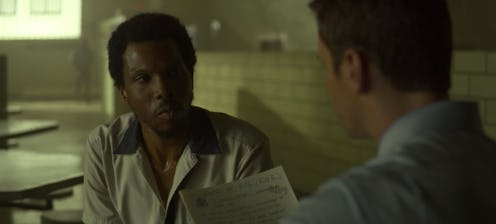Entertainment
This Subject From 'Mindhunter' Had His Case Go All The Way To The Supreme Court

Mindhunter simply features too many infamous killers to give each of them the same amount of time and focus as Edmund Kemper or the BTK Killer. However, one alleged killer featured in Season 2 of Mindhunter is worth taking a deeper dive into, as Mindhuter barely scratches the surface of his confounding life story. Like most of the killers featured in the series, William Henry Hance from Mindhunter Season 2 is based on a real person. But Corey Allen's performance as the real life figure is just the tip of the iceberg when it comes to Hance's case, which had ramifications that extended all the way to the Supreme Court.
Some of Hance's encounter with the BSU is fictionalized — Hance spoke with Robert Ressler, the real person who inspired Mindhunter character Bill Tench, who isn't present for the scene in the series — but much of the account of Hance's crimes are true, pulled from Ressler's book Whoever Fights Monsters. Hance was convicted following his confession to the murders of Gail Jackson and Irene Thirkield in 1978, and was convicted for the murder of soldier Karen Hickman that same year.
All of the details featured in Mindhunter, such as his claims to be a group called the "Forces Of Evil", his choice to write letters to the police using the stationary of his military station while writing for the reader to not pay attention to the letterhead, and telling the police where to find Jackson's body, come from Hance's real-life actions.
Holden eventually discerns that he's not going to get much insight from talking to Hance, but there's still more to Hance's story than what viewers see in Mindhunter. While Mindhunter focuses on the violence that men inflict on others, the larger story of Hance's case concerns how the criminal justice system can perpetuate violence and mask it as justice.
As reported in the New York Times, Hance was sentenced to the electric chair in 1978 for Jackson's murder by a unanimous decision of the jury, which Georgia requires in the case of a death penalty. However, Gayle Daniels — the only black juror on Hance's case — later came forward and stated that she did not vote to put Hance to death and that the jury foreman lied about having a unanimous verdict. In an affidavit obtained by the New York Times, she stated, "I did not vote for the death penalty in Mr. Hance's case because I did not believe that he knew what he was doing at the time of his crimes." Fellow juror Patricia Lemay later corroborated her story and revealed that deliberations in the jury room were marked by racist comments and statements that Hance was "just one more sorry n***** that no one would miss."
Hance's lawyer, Gary Parker, took this case to the Supreme Court, stating that because the jury foreman falsified the details of the verdict, then that verdict should be appealed. The appeal was denied, and after Supreme Court Justice Anthony M. Kennedy lifted the stay that delayed Hance's execution so that Parker could appear in front of the Supreme Court, Hance was executed.
There are no simple answers in the case of Hance, just a lot of complex questions raised. While he was found guilty of having committed murder, does that justify a death sentence from a jury that may be making a decision rooted in bigotry? Is a jury truly unbiased if they express racist sentiments? The larger story of Hance's case is far outside the purview of Mindhunter but it's a chilling reminder that justice is rarely cut-and-dry, and it is all too easy for the criminal justice system to erase the voices of marginalized persons.